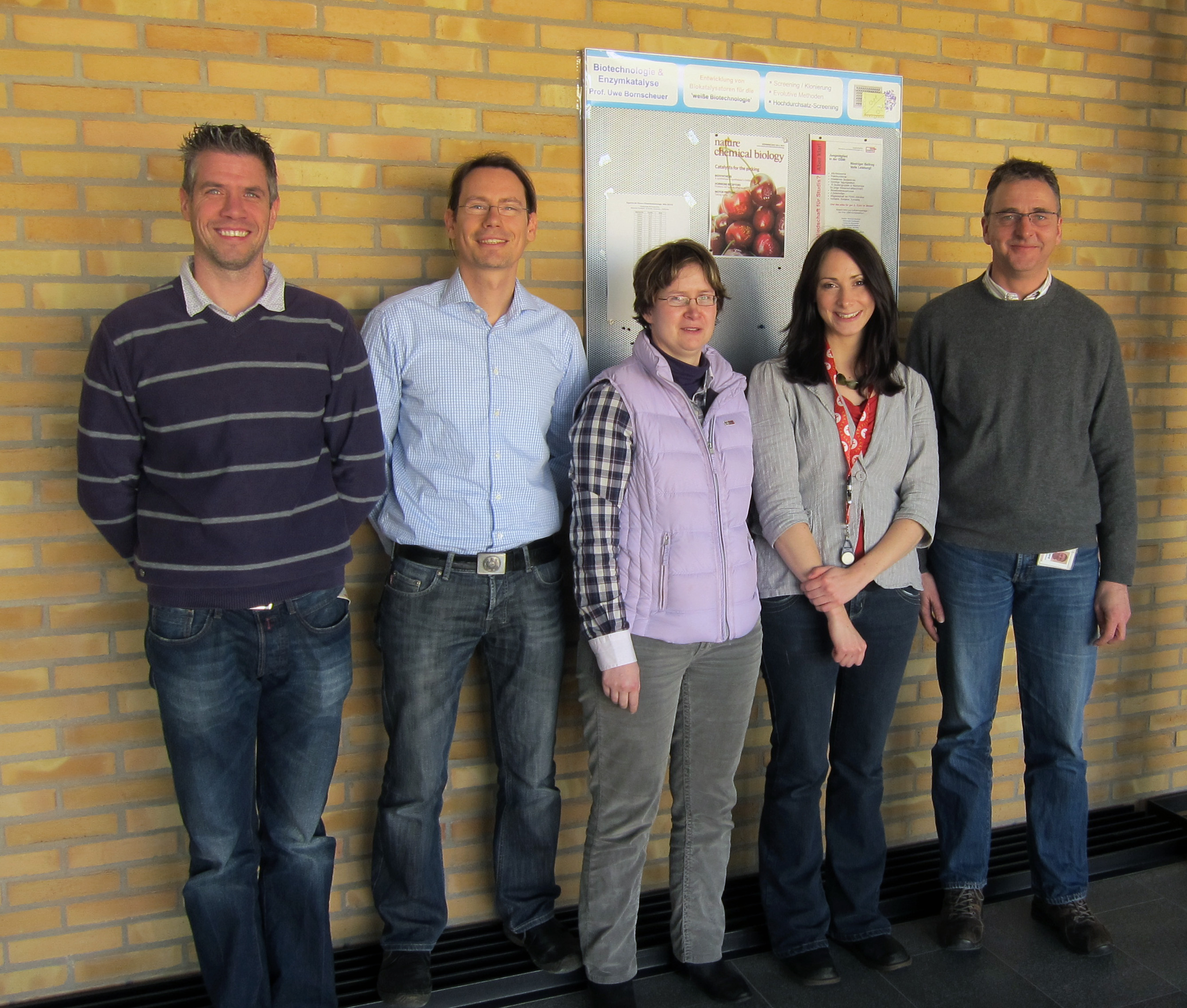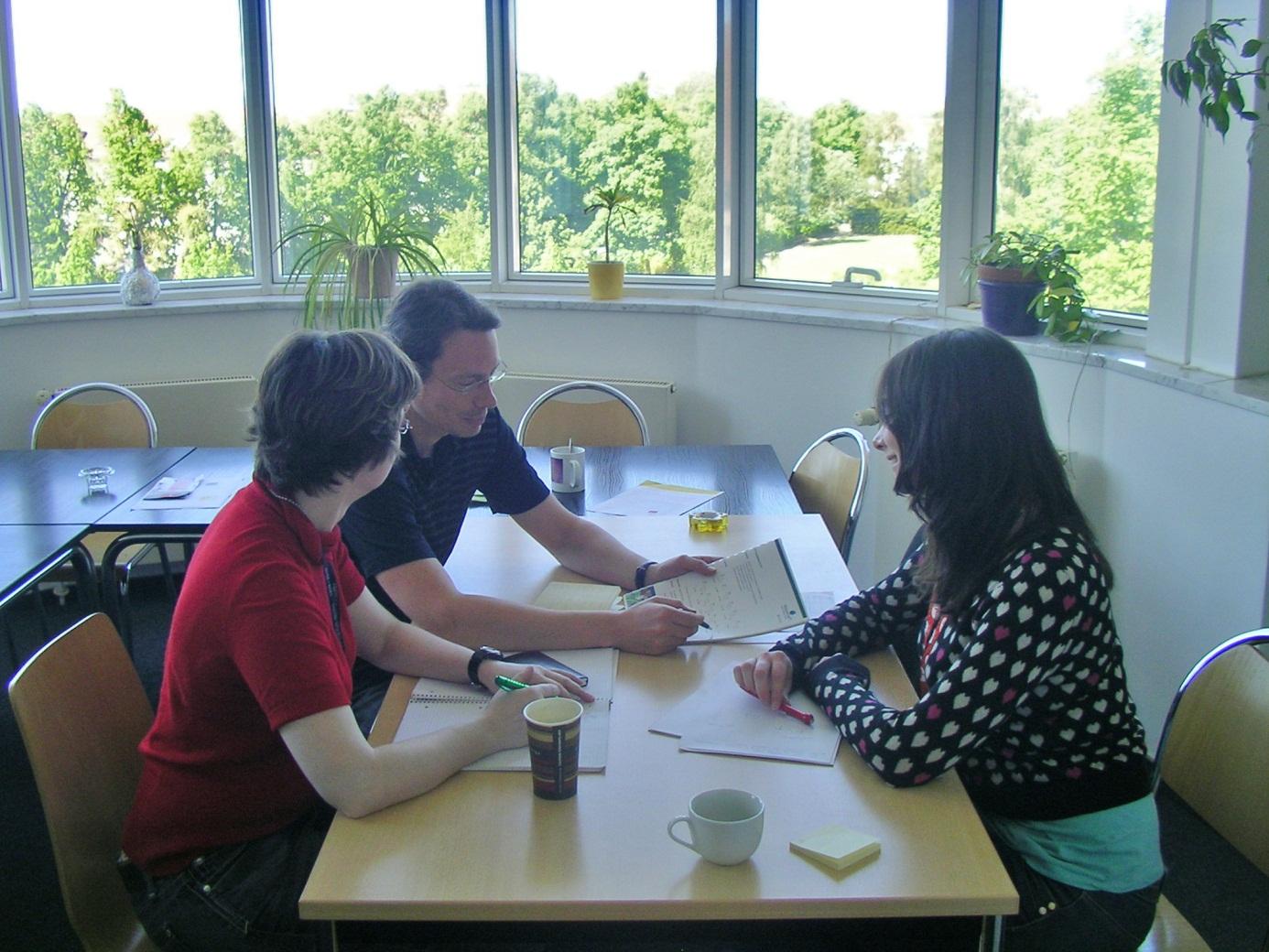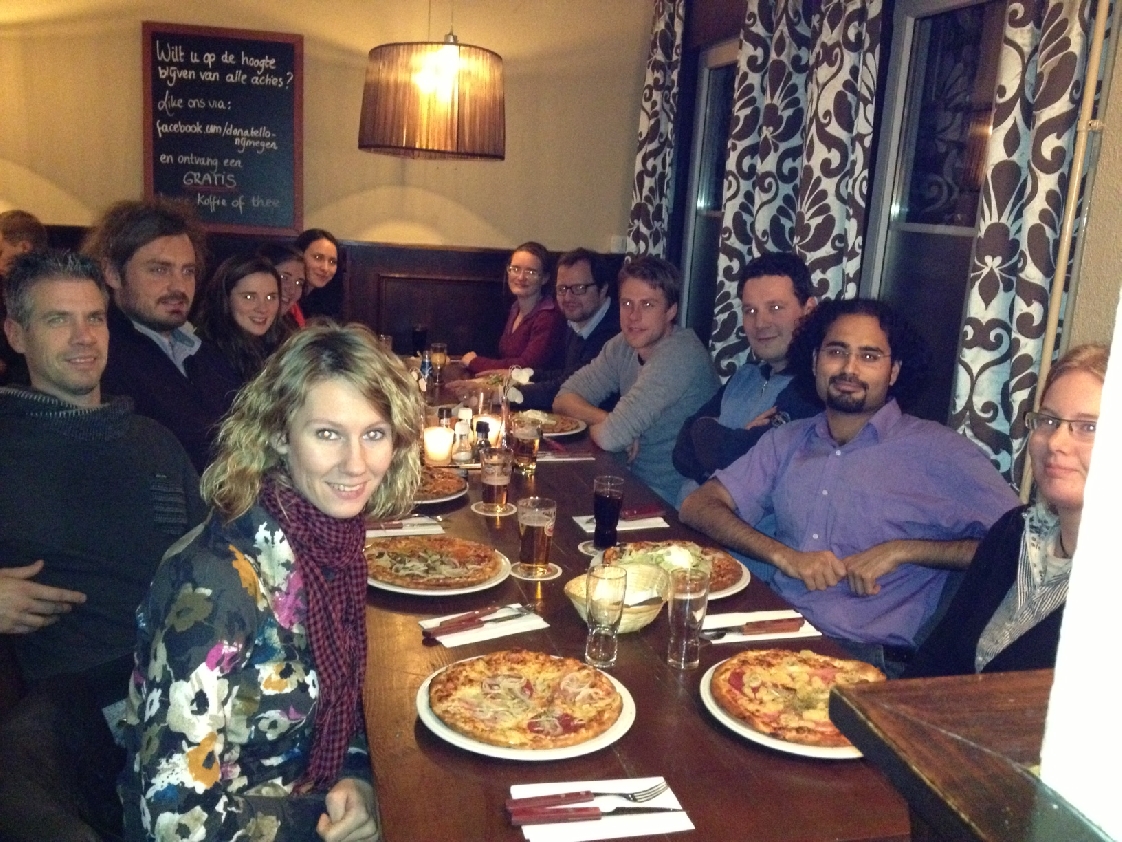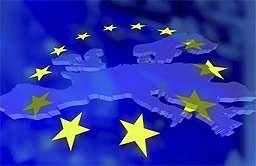| Back to Restricted |
(Small) delivered deliverables
This page will hold descriptions of small activities that either were
not planned (and thus are extra deliverables), or that were planned and
are part of a bigger deliverable that is due 'in due time'.
|
March 2012, Bio-Prodict:
The RmlC-like cupin superfamily 3DM database was generated.
The pyridoxal-5'-phosphate dependent transferase 3DM database was generated.
The 2-methyl-dehydratase 3DM database was generated.
We have delivered the pyridoxal-5'-phosphate dependent transferase 3DM database
to the Greifswald partner and gave a one day course to the partner on how to use the system.
Several new features have been developed:
A module that can collect reaction data (substrate, product) for the protein superfamily
members.
A module that connects mutation data from literature data to Yasara.
|
March 2012, Meeting in Greifswald
Three of the partners met in Greifswald as part of the deliverable listed
above this one:

From left to right: Dr. Joosten (Bioprodict), Dr. Wardenga (Enzymicals AG),
Dr. Brundiek (Enzymicals AG), Dr. Vickers (University of Greifswald),
Prof. Bornscheuer (University of Greifswald).
|
March 2012, Meeting in Brno
In March a bilateral Fluid-Enantis meeting took place in Brno. Feel free to look at the
minutes of this meeting.
|
April 2012, Meeting at Ingenza
Henk-Jan Joosten from Bio-Prodict visited Ingenza on April 25th for the
first part of our formal training on the use of 3DM databases. Three
Ingenza staff were trained (Reuben Carr, Franck Escalettes and myself)
and a further 2 have since begun practising using the database. We have
one superfamily database already built and have ordered the next one.
|
May 2012, Meeting in Greifswal between Uni Greifswald and Enzymicals
Date: 25.05.2012, 10-15 Uhr
Location: Biotechnikum, Greifswald
Participants:
Dr. Vickers (University of Greifswald)
Dr. Brundiek (Enzymicals AG)
Dr. Wardenga (Enzymicals AG)
Content: Discussion within the NewProt project: Selection of target compounds, wild-type enzymes and mutation strategies
Describing the project objectives and discussion on the following topics:
A list of relevant target compounds containing chiral amino functions are presented and discussed
Chiral building blocks for these compounds are identified and categorized
Selection of concrete targets for investigation of reactivity with available ATAs
Presumed hindrance for conversion are the structure of the small binding pocket (SBP)
Expanding the substrate acceptance of small binding pocket as mutagenesis target
Selection of three concrete model substrate for investigations and screening procedures
Analytical methods are established
3DM based investigations yielded in a loop exchange strategy to expand the accessibility of the SBP of dedicated ATAs
This is our first mutation strategy
Generation of homology models with YASARA
Next tasks:
Investigation with available ATAs with model substrates and final selection of wt-enzymes
Validation of homology models with YASARA
Analysis of the sequence area which forms the SBP
Analysis of the models with HotSpot Wizard
Results will deliver a second mutation strategy
Generation of mutants for both strategies
Experimental validation of mutants
Both partner will closely cooperate in molecular biology and biochemical work

|
June 2012 New release of 3DM in alpha testing
With inclusion of many new facilities that were suggested by especially the
teams in greifswald, a new 3DM release went into alpha-testing in June.
This release contains major improvement for usage in protein engineering
experiment design:
- Major improvement of the 3DM website making 3DM usage more intuitive for protein engineers.
- Easy generation of sequence subsets
- Improved search algorithms
- Easy data comparisons between subsets
- Faster, interactive visualization of alignments
- Automated data transfer between yasara and 3DM:
Structure selection directly from Yasara
- Data visualization in relation to subsets
- HUD data printing (e.g amino acid distributions)
- Easy switching between different 3DM options via an intuitive icon based structure
- Automated regeneration of sub 3DM systems
- Incorporation of enzyme reaction data (substrate, product, etc)
- New interactive network plotting algorithms for analysis of correlated mutations.
|
June 2012 Experimental validation in Greifswald
Utilizing the PLP dependent transferase 3DM database in the design of
amino transaminases (ATAs) as synthetically useful biocatalyst.
The aim of this study is to develop an (S)-ATA which can accept
substrates with substituents on the ketone moiety larger than a
methyl group. Analysis of the X-ray crystal structures of 4 enzymes
(3HMU, 3I5T , 3GJU and 3FCR) identified 4 loops which could influence
the substrate specificity of the enzymes. 1 of these 4 loops was chosen
as a target for mutagenesis. A loop exchange strategy where the 'short'
Loop 1 of 3I5T will be exchanged with the long Loop 1 of 3HMU (with
3HMU acting as the scaffold) is proposed. Thanks to the database, 3DM
analysis of the amino acid distribution in the target Loop of 3HMU
identified a highly conserved phenylalanine pair which should be
considered in the design of further loop exchange mutants. CMA,
using the 3DM tool Comulator, of both the 3HMU subfamily and the
short loop 3I5T sequences revealed correlation between residues located
in two different loops. This toll will also be used to guide further
mutant design. Experimental verification and choice of substrates has
been done and will be continued with close cooperation with project
partner Enzymicals AG.
|
June 2012 coordination meeting
In June the coordinators (Vriend and Bornscheuer) had a long Skype session discussing
the following aspects: Experimental validation, overall progress, software developments.
It was decided that Bornscheuer would make a Skype around along the experimental partners
and Vriend along the software partners. In August Vriend and Bornscheuer will Skype again
and the half-year report will then be drafted and placed in the portal reporting section.
|
July 2012, SAFAN visits Nijmegen
As SAFAN (Luisa Pugliese) missed the kick-off meeting because of a medical emergency,
it was decided to have a more extensive Nijmegen trip for SAFAN in the summertime. Nijmegen was chosen
because three of the four partners forwith whom SAFAn will perform the dissemination,
documentaion, education activities work in or near Nijmegen. Luisa reported:
"Sunday July 1st I arrived in Nijmegen for the meeting with other partners of the project.
Monday July 2nd I started analysing how one of the softwares to be included in the NewProt
portal works in order to understand what would be important for the potential pharmaceutical users
of the NewProt portal.
Tuesday 3rd I gave a seminar on S.A.F.AN. BIOINFORMATICS activity in presence of prof.
Gert Vriend, coordinator of the project, Dr. Sander Nabuurs from Lead Pharma and Dr.
Henk-Jan Joosten from Bio-Prodict.
On Wendsday 4th I visited Bio-Prodict and we discussed with Dr. Henk-Jan Joosten my
possible involvement in the 3DM course that will be held in November in Nijmegen and
the considerations I made analysing the 3DM software on Monday".
These three days Luisa stayed in Gert Vriend's private guesthouse which allowed for
further extensive discussions in the evening hours. the meeting was a success, both in terms of
scientific exchange of ideas, and in terms of heigthening the socail interactions between the partners.
|
July 2012, Nijmegen and BioProdict visit Walldorff
Mid July Remko Kuipers (BioProdit's main 3DM programmer) and G Vriend visited
Fluid Ops in Walldorf for a two-day meeting on formats, 3DM inclusion in the portal,
and other interoperability issues.
At this meeting an interoperability format for software partners has been discussed. This
format will be part of the operational document Fluid is writing to guide their future
portal developments.
This document is a restricted Deliverable.
We feel that the software developments all are reasonably well on track to deliver in time.
|
September 2012, Nijmegen visit Walldorff
After the succesful meeting in July Gert Vriend visited Fluid Ops in Walldorff early
September 2102 to dot the i-s and cross the t-s. The meeting lasted just a few hours, but
was important because we now know for sure that al things related to the interoperability
are understood the same way by all partners.
The seminar presented by Fluid Ops at this meeting will be placed here soon.
|
Spring/summer 2012 contacts between Bio-Prodict and Ingenza
The first two years of the project Ingenza will have most contacts with NewProt through
Bio-Prodict because their role is to validate the software experimentally. The Bio-Prodict
3DM package is ready for testing, and YASARA is available to Ingenza through Bio-Prodicts 3DM.
The Ingenza - Bio-Prodict contacts so far have been (reported by Ingenza):
- Henk-Jan Joosten from Bio-Prodict visited Ingenza on April 25th for the first part
of our formal training on the use of 3DM databases. Three Ingenza staff were trained
(Reuben Carr, Franck Escalettes and myself) and a further 2 have since begun practising using the database.
- Internal training using YASARA built-in training tools to gain expertise in protein molecular modelling.
- Two 3DM systems have been supplied by Bio-Prodict (2-methylcitrate dehydratases,
PLP-dependent transferases . Ingenza has begun to study the methyl citrate superfamily to
identify suitable steis for mutagenesis. A third database based on tyorsine or phenylalanine
ammonia lyase has been ordered.
- We have cloned 3 enzymes from a thermophile which enable the chain elongation of
alpha-keotacids (two are oxidoreductases). Two of the three proteins are active (by
spectrophotometric and HPLC assay). The third is currently being tested. A database built
around one sequence for the OR enzymes will be ordered. Specifically we will be attempting
to increase the activity and oxygen stability of these proteins by comparison to stable
enzymes within the superfamily. The activity of the cloned proteins is low at low temperature,
we will try to identify enzymes with better activity at lower temperatures.
|
Bio-Prodict 3DM user courses
Bio-Prodict has started with user courses for their customers and grant partners. These 3-day courses
are held in the CMBI teaching room. At one of the first courses Claire Vickers from Greifswald was present:

|
Portal Skype session minutes
PMP linked to NewProt:
- The PMP models cannot be imported into the portal directly due to legal issues. Our solution is to make a button "find external models" that will show the PMP UI in a popup window. Here the user can find links to external models.
- The popup window will only show the graph with colored bars to indicate the coverage of the models and the table that shows the provider/template/sequence identity/coverage/etc of the models. So basically, all the model information that can already be found on the PMP site now. Juergen will help by making a separate website for the Newprot project.
- We will need to state very clearly in the text that the user can download these models and upload them all by themselves. In the freeware version we can add text about the good and automatic modelling options in YASARA that will become available when the user buys the full package.
Other points:
Andreas is working on a generic method to incorporate webservices. The HSSP webservice made by Coos is finished now and could be the first test-case. This webservices will show the variablity of a residue on a certain position in the sequence.
Other services that produce a file in the newprot format can be added in next steps.
The Hotsport-wizard output can now be shown in a nice table. The data is available in
rdf-format.
|
Meeting in Stockholm Feb 2013
Several scientists from Greifswald (University of Greifswald and from Enzymicals AG) from the NewProt project attended the
1st International Symposium on Transaminase Biocatalysis held in Stockholm, Febr. 28-March 1st 2013
(http://www.biotech.kth.se/biochem/transam/index.html).
Their results were presented in three invited lectures and four posters.
Lectures:
- U.T. Bornscheuer: In silico Discovery and Application of Transaminases in Organic Synthesis
- E. Byström, H. Mallin, J. Muschiol. M. Höhne, U.T. Bornscheuer A novel mass transfer concept to facilitate enzyme-catalyzed reactions
- M. Höhne: Connecting unexplored protein crystal structures to enzymatic function: Identification of novel amine transaminases
Posters:
- E. Champla, M. Patila, I.V. Pavlidis, H. Stamatis, M. Höhne, U.T. Bornscheuer: Efficient immobilization
of -transaminases onto functionalized carbon-based nanomaterials
- H. Land, S. Chen, F. Steffen-Munsberg, A. Nobili, M. Hoöhne, U.T. Bornscheuer, P. Berglund: Semi-rational design to obtain a stable mutant of
Chromobacterium violaceum amine transaminase
- C. Vickers, A. Mitin, A.V. Barro, H. Brundiek, A. Nobili, F. Steffen-Munsberg, M. Höhne, U.T. Bornscheuer: A strategy to enlarge the small
binding pocket of (S)-selective amine transaminases
- U. Menyes: Synthesis of chiral building blocks and fine chemicals with unique enzymes
|
August 2013. Portal design meeting
Hanka and Andreas regularly discuss design aspects of the portal. In these sessions Hanka discusses an integration
of the user comments. Not all minutes of these meetings end-up here, but the August 2013 meeting is guiding the
project till the anual meeting in November, so these minutes are a bit more important:
Visualization of the NPF files
- Recently, the portal was updated to have the latest options available. One of the major new features is the visualization of the NPF files (e.g. computed from any of the included services) as a YASARA scene file. Currently the option to create and download the scene is located at the NPF-file page. Andreas will move the “create” and “download-option” to the structure page and combine them in one button.
- Andreas will make sure that all the generated YASARA-scenes have unique and descriptive names.
- The YASARA-scene created for ProlineMutation-values does not show the correct results yet, probably caused by the -999,99 values in the output. These values should be ignored as this is WHAT IF’s way to indicate values that could not be calculated. However, the value lies within the range of -1000 to 1000. Hanka will contact Maarten or Gert to see how we can change the range.
- Gert is going to work on new services that can be incorporated in the Portal soon. Now the framework is ready it should be easy to add new services.
HotSpotWizard/PMP
- The HotSpotWizard had some small problems which are currently solved. It also changed its port which caused some firewall problems for the NewProt Portal. Andreas will discuss this with their system administrator soon.
- PMP is still showing both the existing structures and models on the same page. Juergen did not reply on the emails yet. Hanka will send another email by the end of next week.
Layout
- The WHAT IF-webservice output will be shown in a large table. We expect to have many different servers and therefore we need to think of a way to visualize the data in a smart and informative way. Andreas and Peter will soon discuss the possibilities here. Options to think about: one large scrollable table, one large table that can be costumized on demand by the user using small collapse-buttons, movable collums, or a system that allows the user to create his/her own table from the available data.
- Hanka will create some new icons for the delete and archive buttons, and help
- Andreas will add the option to archive projects directly on the user-welcome page.
- The Workbench has an option to add a help-function. This is a little icon that will cause a pop-up with a helpful text. Hanka will think about the location and text-for these help-buttons.
|
reserved for next item
|
reserved for next item
|
|
|



